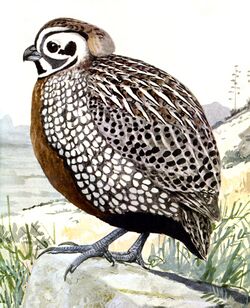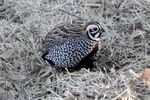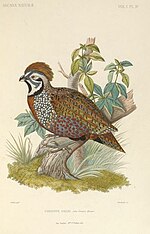Biology:Cyrtonyx
From HandWiki
Short description: Genus of birds
| Cyrtonyx | |
|---|---|

| |
| Cyrtonyx montezumae | |
| Scientific classification | |
| Domain: | Eukaryota |
| Kingdom: | Animalia |
| Phylum: | Chordata |
| Class: | Aves |
| Order: | Galliformes |
| Family: | Odontophoridae |
| Genus: | Cyrtonyx Gould, 1844 |
| Type species | |
| Ortyx montezumae Vigors, 1830
| |
Cyrtonyx is a bird genus in the New World quail family Odontophoridae.
The genus Cyrtonyx was introduced in 1844 by the English ornithologist and bird artist John Gould.[1] The name combines the Ancient Greek kurtos meaning "curved" and onux meaning "nail" or "claw".[2] The type species is the Montezuma quail (Cyrtonyx montezumae).[3]
Species
The genus contains three species:[4][5]
| Image | Common Name | Scientific name | Distribution |
|---|---|---|---|
 |
Montezuma quail | Cyrtonyx montezumae | Mexico, Southwest United States |
| Ocellated quail | Cyrtonyx ocellatus | Mexico, Guatemala, Honduras, El Salvador, and Nicaragua | |

|
Salle's quail | Cyrtonyx sallei | Michoacán, Oaxaca, Guerrero, and Puebla, Mexico |
References
- ↑ Gould, John (1844). A Monograph of the Odontophorinae, or Partridges of America. London: Printed by Richard and John E. Taylor. Plate [7] and text. https://www.biodiversitylibrary.org/page/55983499.
- ↑ Jobling, James A. (2010). The Helm Dictionary of Scientific Bird Names. London: Christopher Helm. p. 129. ISBN 978-1-4081-2501-4.
- ↑ Peters, James Lee, ed (1934). Check-List of Birds of the World. 2. Cambridge, Massachusetts: Harvard University Press. p. 57. https://www.biodiversitylibrary.org/page/14482870.
- ↑ Gill, Frank; Donsker, David; Rasmussen, Pamela, eds (2020). "Pheasants, partridges, francolins". IOC World Bird List Version 10.2. International Ornithologists' Union. https://www.worldbirdnames.org/bow/pheasants/.
- ↑ IUCN (2020-08-26) (in en). Cyrtonyx sallei: BirdLife International: The IUCN Red List of Threatened Species 2020: e.T22724748A178118227 (Report). doi:10.2305/iucn.uk.2020-3.rlts.t22724748a178118227.en. https://www.iucnredlist.org/species/22724748/178118227.
Wikidata ☰ Q388322 entry
 |

